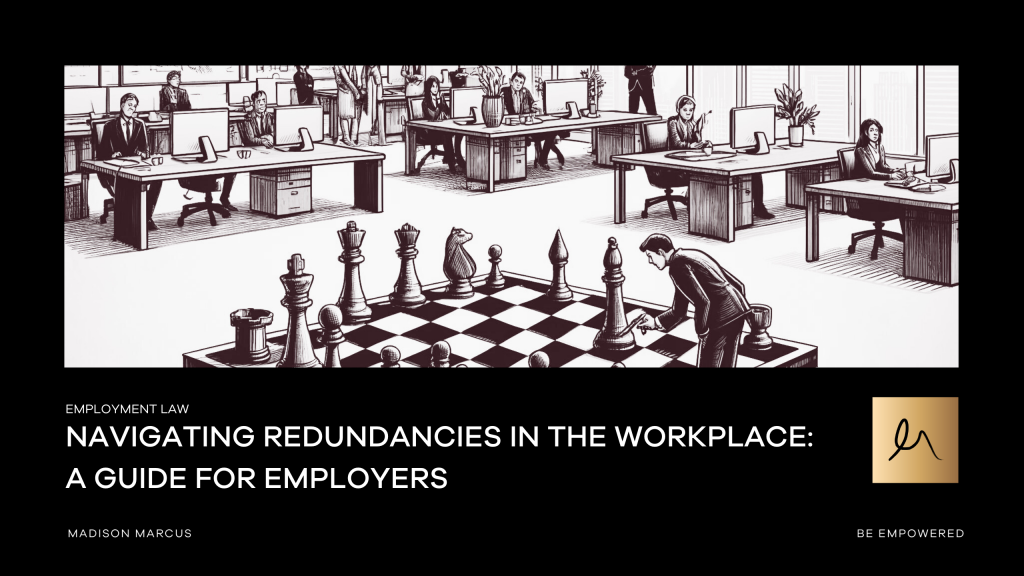Redundancies have been a hot topic in the media lately, with discussions swirling around the challenges faced by employers in managing staff cuts.
See, for example, this article by Emily Chantiri in The Sydney Morning Herald: “People Kept Disappearing: Should You Take a Redundancy?“
In today’s dynamic business environment, whether due to economic downturns, technological advancements, or organisational restructuring, planning and executing redundancies demand careful consideration of legal obligations.
The cornerstone of any redundancy process is ensuring its genuineness. Section 385 of the Fair Work Act effectively excludes redundancies from being found to be a case of Unfair Dismissal so long as the redundancy is “genuine”.
Section 389 of the Act then sets out the three basic parameters for what amounts to a genuine redundancy.
1. The Role Ceases to Exist
Redundancies must be driven by legitimate business reasons rather than discriminatory motives or as a means of dismissing unwanted employees.
Redundancy must occur when the employee’s position ceases to exist due to “changes in the operational requirements of the employer’s enterprise”. This has been taken to mean that the employee’s job duties are no longer required to be performed by anyone.
Broadly speaking, this could arise due to technological advancements, changes in market demand, or organisational restructuring. Case have, in the past, focussed on several factors:
-
Economic Necessity: Employers can demonstrate that redundancies are necessary due to economic factors such as financial difficulties, market changes, or technological advancements that render certain roles obsolete.
-
Operational Requirements: Redundancies should align with the organisation’s operational needs, including restructuring initiatives, changes in business direction, or the closure of specific departments or divisions.
-
Fair Selection Criteria: Employees selected for redundancy must be chosen based on fair and objective criteria, such as skills, performance, qualifications, and length of service, rather than discriminatory factors, for example, age, gender, or disability.
2. The Need for Consultation
Consultation is a fundamental aspect of the redundancy process and plays a crucial role in promoting fairness, transparency, and employee engagement. Section 389 creates a legal obligation to consult with affected employees throughout the redundancy process. Such consultation should include:
-
Early Notification: Employers should inform employees of the proposed redundancies as soon as practicable, providing sufficient time for consultation and consideration of alternative options.
-
Open Dialogue: Consultation involves meaningful discussions with affected employees, allowing them to express their views, raise concerns, and explore potential alternatives to redundancy.
-
Consideration of Alternatives: Employers must genuinely consider alternative measures to redundancy, such as redeployment, retraining, part-time work, or voluntary redundancy schemes, where feasible.
3. Reasonable Redeployment Efforts:
One key obligation employers face during redundancy processes is to explore opportunities for reasonable redeployment. The Act states that a redundancy is not genuine if the employee could have been redeployed.
Redeployment involves offering affected employees suitable alternative roles within the organisation, thereby mitigating the need for redundancies where possible. Key considerations for reasonable redeployment include:
-
Assessing Suitable Roles: Employers should identify available roles that match the skills, qualifications, and experience of affected employees, ensuring they are genuinely suitable and comparable to their previous positions.
-
Communication and Engagement: Employers must communicate effectively with affected employees regarding redeployment opportunities, providing clear information about available roles, requirements, and support mechanisms.
-
Training and Support: Employers should offer training, mentoring, or support programs to help employees transition into new roles successfully, addressing any skills gaps or concerns that may arise during the redeployment process.
Calculation of Redundancy Pay:
In Australia, redundancy pay is governed by the National Employment Standards (NES) under the Fair Work Act 2009.
Key considerations include:
Entitlements:
Employees covered by the NES are entitled to redundancy pay if they have completed at least 12 months of continuous service with their employer and the redundancy is not due to serious misconduct. The amount of redundancy pay is based on the employee’s length of service and their ordinary weekly earnings, subject to the NES.
Taxation:
Redundancy payments may have tax implications for both employers and employees. While redundancy payments are generally tax-free up to a certain limit for employees, any amount exceeding this threshold may be subject to tax at the employee’s marginal tax rate. Employers are required to withhold PAYG tax from any taxable redundancy payments made to employees. An employer must take appropriate accountancy advice before finalising redundancy entitlements.
Superannuation:
Redundancy payments may also impact an employee’s superannuation entitlements. Employers should ensure that any superannuation contributions owing on redundancy payments are calculated and paid in accordance with legal requirements.
Planning staff redundancies in Australia necessitates a thorough understanding of legal obligations and best practices to ensure compliance and fairness.
The employer may be required to demonstrate that the redundancy was genuine as defined by the Act. This may involve demonstrating the reasons behind the role ceasing to exist, the engagement in meaningful consultation, and reasonable redeployment options.
Lastly, care must be taken when calculating redundancy pay while addressing tax implications. Employers should consider taking professional advice to ensure compliance and to mitigate potential risks associated with redundancies.








